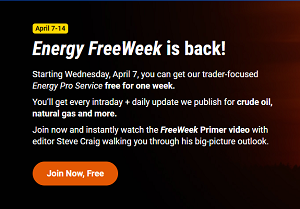
Top Oil Stocks To Watch In U.S. Shale As New No. 1 Emerges In Permian Basin By Investors Business Daily
Energy Pro Service FreeWeek April 7-14
Almost exactly a year ago . . . oil prices went negative $40. Today, with crude trading at $60, you hear lots of opinions as to what’s next. “Electric car revolution” . . . “reopening economy” . . . “end of commute” . . . “start of travel season” . . . bullish . . . bearish. Who’s right? Who’s wrong? We get the challenge – and we’re ready to offer you instant, objective answers. Get Some Uncommon Market Clarity — Free.
Top Oil Stocks
When weighing oil stocks to buy and watch, consider which ones are diversified and which are focused more on shale or particular regions like the Permian Basin. Crude oil prices have a big impact, especially on pure-play shale producers.
A series of takeover deals is reshuffling some shale oil stocks, and now Pioneer Natural Resources (PXD) is poised to become the top producer in the Permian Basin.
Investors should do additional research before making any purchases. While oil prices have risen recently, they are still under pressure amid another round of lockdowns in Europe and growing Covid-19 cases in India.
But for reference purposes here are the top stocks involved in U.S. shale as of April 2021.
Exxon Mobil, Chevron
Exxon Mobil (XOM) is the world’s largest publicly traded oil company by market cap ($240 billion), despite a sharp decline, with operations around the world from deepwater drilling off the Australian coast to conventional drilling in the Middle East.
Exxon also doubled its holdings in the Permian Basin, which accounts for one-third of U.S. production, with a $5.6 billion deal in 2017. But drilling has been curtailed as oil prices fell amid the coronavirus pandemic. Exxon now sees volumes of approximately 700,000 barrels per day by 2025, down from an earlier view of more than 1 million bpd by 2024.
In February, Exxon reported mixed fourth-quarter results. It was booted off the Dow Jones Industrial Average in August.
Exxon hopes investment and job cuts will help maintain its quarterly dividend at 87 cents a share. CEO Darren Woods told analysts that Exxon can maintain its dividend with Brent at $45 a barrel, while $50 would allow the company to focus on reducing debt or returning capital to investors. But Wall Street remains skeptical.
Meanwhile, global oil rival Chevron (CVX) is closing in on Exxon’s dominance with a $200 billion market cap and is the only oil major on the DJIA. In July, Chevron agreed to buy Noble Energy for $5 billion, increasing its presence in the Permian Basin, as well as in the eastern Mediterranean and West Africa.
Chevron and Exxon reportedly engaged in preliminary merger discussions in 2020, sources told the Wall Street Journal. The talks aren’t currently ongoing but sources told the Journal the discussions could be revisited in the future.
Chevron reported an unexpected Q4 loss in January.
ConocoPhillips
ConocoPhillips (COP) is one of the biggest Permian Basin producers and the largest U.S. independent oil company following its acquisition of Concho Resources in an all-stock deal valued at $9.7 billion. Conoco’s market cap is $71 billion after the deal closed in January.
Combined production is expected to hit 1.5 million barrels per day, according to an earlier Reuters report.
Concho reported Q4 results that beat Wall Street estimates in January on increased output from its Canadian operations.
EOG Resources
EOG Resources (EOG) is known as the “Apple of Oil” for its use of technology and big data to aid in drilling operations. The company has a $41 billion market cap.
The company has premium acreage in the Eagle Ford shale formation in south Texas and the Permian’s Delaware Basin.
EOG beat analyst expectations when it reported Q4 results in February. It sees 2021 crude oil production at 440,000 barrels per day, up from 2020’s full-year average of 409,200 bpd.
EOG is allocating more capital in 2021 to test high‐impact oil plays and lease acreage and sees capital spending at $3.7 million -$4.1 million for the year, up from $3.5 million in 2020.
Pioneer Natural Resources
Pioneer Natural Resources is a pure-play Permian Basin company after selling its Eagle Ford assets in 2019. It has a market cap of $35 billion.
In April, Pioneer agreed to buy DoublePoint Energy for $6.4 billion for nearly 100,000 acres in the core area of the Permian basin.
That followed a deal to buy Parsley Energy in an all-stock transaction valued at about $4.5 billion back in October. The merger is a family affair as Pioneer CEO Scott Sheffield is the father of Parsley’s co-founder and chairman, Bryan Sheffield. Parsley’s CEO, Matt Gallagher, had previously worked at Pioneer.
With both deals, Pioneer will have roughly 1 million net acres in the Permian and become the largest oil producer in the prolific basin, according to company officials. That will put it ahead of Occidental Petroleum (OXY) in the Permian.
Pioneer reported Q4 results that beat estimates in February. Following the Parsley merger, the company sees capital spending of $2.5 billion-$2.8 billion this year with oil and gas production of 528,000-554,000 bpd.
Occidental Petroleum
Like Exxon Mobil and Chevron, Occidental Petroleum is a global company but is also the largest acreage holder in the Permian. It has a market cap of $23 billion. Occidental expanded holdings in the prolific play after buying Anadarko for $38 billion in 2019.
To focus on the Permian, Occidental Petroleum sold off an oil field in Qatar to state-owned Qatar Petroleum in 2019. But it still has operations in Oman, Colombia and Libya. But some investors aren’t happy with the deal and activist investor Carl Icahn and other shareholders were upset they were denied a vote on the deal.
Occidental reported Q4 results in February that fell short of expectations. But it backed its 2021 capital spending plan of $2.9 billion while forecasting production would be flat vs. Q4 at about 1.14 million oil-equivalent barrels per day.
Continental Resources
Unlike many of its shale peers, Continental Resources (CLR) didn’t rush to gain acreage in the Permian and instead kept its focus on North Dakota’s Bakken play. The company is the largest producer in the Bakken. It has also been aggressive recently in Oklahoma’s STACK and SCOOP shale plays. It has a market cap of $9.4 billion.
Continental reported mixed Q4 results in February. It set a $1.4 billion capital expenditures budget. That’s up from its preliminary budget in November of $1.2 billion-$1.3 billion. Annual oil production is expected to range from between 160,000 to 165,000 bpd.
Harold Hamm, Continental’s founder and CEO, stepped down last year and assumed the role of executive chairman. Former ConocoPhillips executive William Berry replaced Hamm.
April 07 to 14 Energy Oil Gas FreeWeek Price Forecasts

